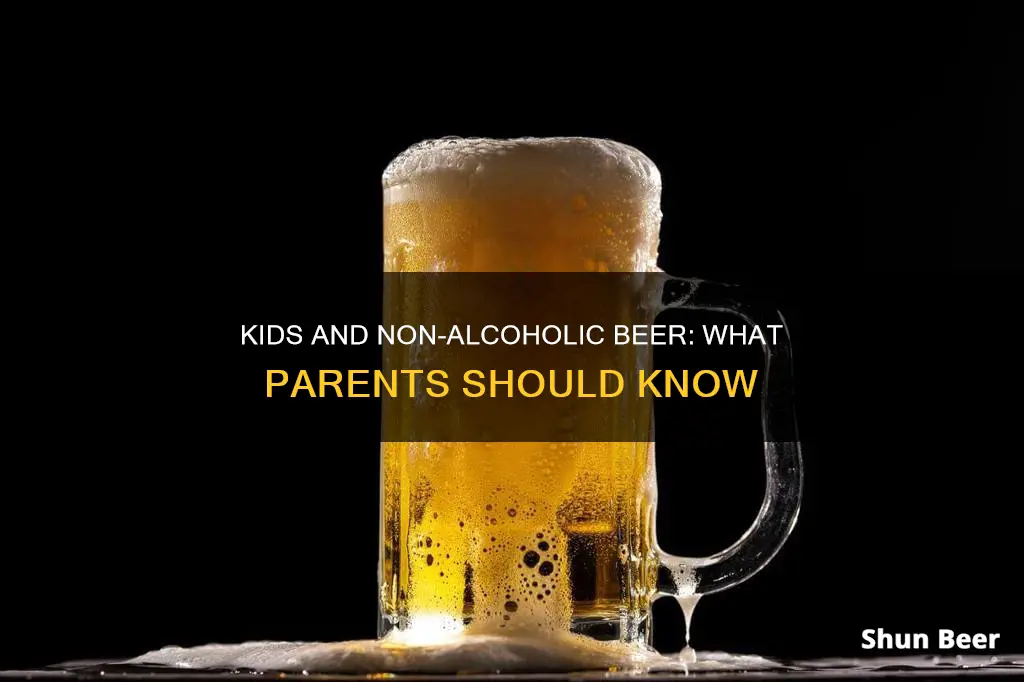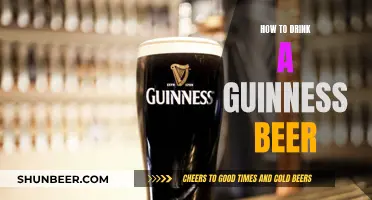
Actress Kristen Bell revealed that her daughters, aged 8 and 9, like the taste of non-alcoholic beer and have even ordered it at restaurants. This has sparked a debate about whether it is appropriate for children to consume non-alcoholic beverages. While some people criticise the decision, others argue that it is a personal family choice. From a legal standpoint, the answer is complicated and varies depending on location. At the federal level in the United States, minors under 21 can consume non-alcoholic drinks, even those with less than 0.5% ABV. However, some states have different regulations, with a few only allowing non-alcoholic beer consumption for those 18 and older, and others prohibiting it entirely for minors. Despite the legalities, health experts advise against children consuming non-alcoholic beer due to potential normalisation and psychological impacts, as well as health concerns.
| Characteristics | Values |
|---|---|
| Legality | In the US, minors under the age of 21 can consume non-alcoholic beverages (federally, at least). However, three states (Mississippi, North Dakota, and Ohio) only allow the drinking of non-alcoholic beer for those 18 and older, and 14 states prohibit minors from drinking non-alcoholic beer. |
| Health Risks | Non-alcoholic beer could increase the risk of addiction and normalise drinking for children. |
| Calories and Carbohydrates | Non-alcoholic beer contains high calories and carbohydrates. |
What You'll Learn
- Non-alcoholic beer can increase the risk of addiction for children
- It may normalise drinking for kids, increasing their interest in alcoholic beverages
- Non-alcoholic beer is not nutritious and contains high calories and carbohydrates
- It may not be the best option for people in recovery from alcohol addiction
- There are differing state-by-state rules regarding the sale and service of non-alcoholic beer to minors

Non-alcoholic beer can increase the risk of addiction for children
Actress Kristen Bell revealed in 2023 that her daughters, aged 8 and 9, like the taste of non-alcoholic beer and have even ordered it at restaurants. While non-alcoholic beer is not considered "beer" under the National Minimum Drinking Age (NMDA) Act of 1984, which covers beverages containing more than 0.5% alcohol by volume, the question of whether children should drink it is complex and controversial.
Normalising Alcohol Consumption
Confusion and Dangerous Consequences
Normalising the consumption of beer can also confuse children, who may not understand the difference between alcoholic and non-alcoholic beverages. They may accidentally consume alcoholic drinks, leading to dangerous consequences.
Genetic and Environmental Factors
Both genetic and environmental factors play a role in the development of substance use disorder. If a child has a family history of addiction, introducing the ritual of drinking beer, even non-alcoholic beer, is especially risky. Normalising alcohol use may increase their risk, given their genetic predisposition.
Long-Term Impact
While non-alcoholic beer is unlikely to have an immediate impact on a child's health, there could be long-term consequences. The consumption of non-alcoholic drinks at a young age may lead to the development of an unhealthy relationship with alcohol later in life.
In conclusion, while non-alcoholic beer is not illegal for minors to consume in most states, it is essential to consider the potential risks and negative impacts on children's health and well-being. The decision to allow children to drink non-alcoholic beer should be made with caution and careful consideration of the potential risks and long-term effects.
Understanding the Basics of Draft Beer Systems
You may want to see also

It may normalise drinking for kids, increasing their interest in alcoholic beverages
Actress Kristen Bell revealed that her daughters, aged 8 and 9, like the taste of non-alcoholic beer and have even ordered it at restaurants. While some people were critical of this, others defended Bell, saying it was a personal family decision.
However, doctors and experts have weighed in on the topic, and the consensus is that it is not a good idea to let kids drink non-alcoholic beer. While non-alcoholic beers are legally defined as those with less than 0.5% ABV, they are not entirely alcohol-free. This means that drinking non-alcoholic beer could increase the risk of addiction for kids and may have a psychological impact on them.
Dr. Chloe Campbell, a paediatrician at Salem Hospital in Salem, Massachusetts, says that research shows that teens who have consumed non-alcoholic beer have more interest in consuming alcoholic beverages. "We plant the seed in young minds that beer drinking is OK," she says, adding that it may lead to beer drinking at a young age.
Normalising the consumption of beer products can also be confusing for children, who may not understand the difference between alcoholic and non-alcoholic beverages. Dr. Campbell warns that "a child mistaking alcoholic beer for one they thought was zero alcohol can lead to dangerous consequences."
In addition to the risk of normalising drinking and increasing interest in alcoholic beverages, there are other potential negative consequences of allowing kids to drink non-alcoholic beer. For example, it could open the door for the body and brain to fall back into familiar patterns of alcohol abuse or addiction, especially for those with a history of substance misuse disorder.
Given these risks, it is clear that allowing kids to drink non-alcoholic beer may have unintended negative consequences and is not advisable.
The Chemistry of Beer: How It Works and Why It Matters
You may want to see also

Non-alcoholic beer is not nutritious and contains high calories and carbohydrates
Non-alcoholic beer is often marketed as a healthy alternative to regular beer, but it is important to remember that it is not a nutritious drink. While it may help reduce alcohol consumption, it contains high levels of calories and carbohydrates, which can be detrimental to physical health.
Non-alcoholic beer is not a nutritious drink, despite what some people may believe. It does not provide significant amounts of vitamins, minerals, or other beneficial compounds. While it may contain small amounts of B vitamins, phosphorus, and magnesium, these are also present in regular beer, and the levels in non-alcoholic beer are not high enough to provide any substantial health benefits.
One of the main drawbacks of non-alcoholic beer is its high calorie content. In fact, it often contains similar levels of calories as regular beer. A cup of standard malt non-alcoholic beer, for example, contains 99 calories, which is comparable to many regular beers. The caloric content of non-alcoholic beers can range from 40 to 120 calories per serving, with some even surpassing the calorie count of regular beer. This high calorie content can be problematic for individuals watching their weight or trying to maintain a calorie-controlled diet.
In addition to high calorie content, non-alcoholic beer also tends to be high in carbohydrates. In fact, it often contains more than twice the amount of carbs as regular beer. These carbohydrates are mostly in the form of sugar, which is added to improve the taste after the alcohol has been removed. The carbohydrate content of non-alcoholic beer can range from 8 to 21 grams per serving, which is significantly higher than that of regular beer. This high carbohydrate content can be concerning, especially for individuals with diabetes or those watching their carbohydrate intake for weight management or other health reasons.
The high calorie and carbohydrate content of non-alcoholic beer can have negative implications for physical health. For individuals trying to maintain a healthy weight or manage health conditions such as diabetes, consuming non-alcoholic beer can be detrimental. It can contribute to excess calorie intake and elevated blood sugar levels, increasing the risk of weight gain and blood sugar spikes.
While non-alcoholic beer may be a good option for adults looking to reduce their alcohol intake, it is important to be aware of its nutritional profile. The high calorie and carbohydrate content can be surprising to consumers who assume it is a healthier alternative to regular beer. Therefore, it is important to treat non-alcoholic beer as an occasional pleasure rather than a health drink, and to be mindful of portion sizes and overall calorie and carbohydrate intake when consuming it.
Growler of Beer: Can You Drink It?
You may want to see also

It may not be the best option for people in recovery from alcohol addiction
While non-alcoholic beer has gained popularity as a healthier, low-calorie alternative to regular beer, it may not be the best option for people in recovery from alcohol addiction.
Non-alcoholic beer is designed to taste and look like traditional beer, but with minimal or no alcohol content. Although the amount of alcohol in non-alcoholic beer is very low, it is important to note that it is not completely alcohol-free. Labels on these beverages often indicate a specific alcohol content, which may be up to 0.5% alcohol by volume (ABV). This means that non-alcoholic beer may still contain traces of alcohol, which could be a trigger for individuals recovering from alcohol addiction.
For people in recovery, consuming any amount of alcohol can be anxiety-inducing and may trigger fears of an unintentional relapse. Additionally, the act of consuming a beverage that resembles beer can lead to a placebo response, triggering sensations or emotions similar to those associated with alcohol consumption. This can have both positive and negative effects, depending on the individual's mindset and intentions.
The consumption of non-alcoholic beer may also remind individuals in recovery of past drinking experiences, potentially disrupting their sobriety and increasing the risk of relapse. It is crucial for those in recovery to assess their own physical and emotional triggers and consult with healthcare professionals or support groups to determine if non-alcoholic beer is suitable for them.
Furthermore, the decision to consume non-alcoholic beer during recovery depends on individual circumstances and preferences. While some people in recovery may find it helpful to have a non-alcoholic option during social situations, others may prefer to abstain completely from any beverage that resembles alcohol. Ultimately, the choice is a personal one, and individuals must consider their own triggers, goals, and support systems when making this decision.
In conclusion, while non-alcoholic beer may be a popular alternative for those looking to reduce their alcohol intake, it may not be the best option for people in recovery from alcohol addiction due to potential triggers, cravings, and psychological implications associated with consuming a beverage that resembles alcohol.
Beer After a Workout: Good or Bad Idea?
You may want to see also

There are differing state-by-state rules regarding the sale and service of non-alcoholic beer to minors
The laws surrounding the sale and service of non-alcoholic beer to minors in the United States are complex and vary from state to state. While the federal government has set the minimum drinking age at 21, individual states have the power to regulate the sale and consumption of alcohol within their borders. This means that each state has its own unique laws regarding the sale and service of non-alcoholic beer to minors, and these laws can be subject to change over time.
In general, minors under the age of 21 are allowed to consume non-alcoholic beverages, even those that contain "less than 0.5% ABV", as these beverages do not fall into the federal government's definition of "beer" in the National Minimum Drinking Age (NMDA) Act of 1984. This Act defines "beer" as:
> "Beer, distilled spirits, and wine containing one-half of 1% or more of alcohol by volume. Beer includes, but is not limited to, ale, lager, porter, stout, sake, and other similar fermented beverages brewed or produced from malt, wholly or in part or from any substitute therefore."
However, when it comes to the purchase of non-alcoholic beer by minors, the laws become more complicated and varied. In some states, minors are not allowed to purchase non-alcoholic beer at all, while in other states, it is not regulated or falls into a grey area. For example, in Ohio, minors must be over 18 to purchase non-alcoholic beer, while in Oregon, West Virginia, and Wyoming, the purchase of non-alcoholic beer with 0.5% ABV or higher is prohibited for those under 21. On the other hand, in Alabama, the sale of non-alcoholic beer is not regulated in wet counties, but it is prohibited in dry counties.
Furthermore, some states have additional laws and exceptions regarding the consumption of non-alcoholic beer by minors. For instance, in Alabama, Louisiana, Mississippi, New Mexico, North Carolina, North Dakota, Ohio, Oklahoma, Oregon, West Virginia, and Wyoming, minors are allowed to consume non-alcoholic beer with parental permission or in the presence of a parent or legal guardian. In contrast, other states, such as Alabama, Arkansas, Idaho, New Hampshire, and West Virginia, prohibit any consumption of alcohol by minors, regardless of the circumstances.
It is important to note that the laws regarding the sale and service of non-alcoholic beer to minors are subject to change and can vary significantly from state to state. Therefore, it is essential to check the specific laws and regulations in your state or local area before making any decisions or taking any action.
Ash Wednesday: Beer Drinking and Religious Observance
You may want to see also
Frequently asked questions
Non-alcoholic beer is not recommended for children as it may increase the risk for addiction and could have a psychological impact on them. It also normalises drinking for children, which could lead to them trying alcoholic drinks at a younger age.
In the US, at a federal level, children under the age of 21 can drink non-alcoholic beer, even those with less than 0.5% ABV. However, some states have different laws, with Mississippi, North Dakota, and Ohio only permitting non-alcoholic beer consumption for those 18 and older, and 14 states prohibiting minors from drinking it at all.
Water and milk are considered safe beverages for children.







